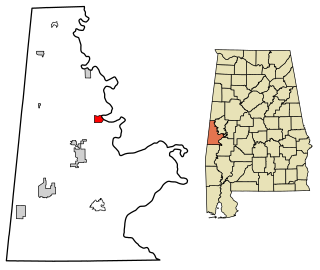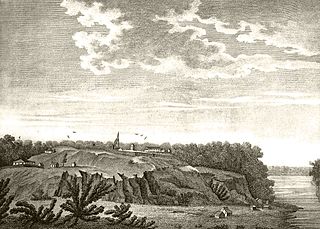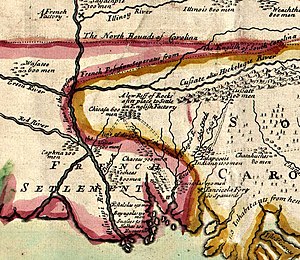
France began colonizing the Americas in the 16th century and continued into the following centuries as it established a colonial empire in the Western Hemisphere. France established colonies in much of eastern North America, on several Caribbean islands, and in South America. Most colonies were developed to export products such as fish, rice, sugar, and furs.

Epes is a town in Sumter County, Alabama, United States. Initially called Epes Station, it was incorporated as Epes in 1899. At the 2010 census the population was 192, down from 206 in 2000.

Henri de Tonti, also spelled Henri de Tonty, was an Italian-born French military officer, explorer, and voyageur who assisted René-Robert Cavelier, Sieur de La Salle, with North American exploration and colonization from 1678 to 1686. de Tonti was one of the first explorers to navigate and sail the upper Great Lakes. He also sailed the Illinois and the Mississippi, to its mouth and thereupon claimed the length of the Mississippi for Louis XIV of France. He is credited with founding the settlement that would become Peoria, Illinois. De Tonti established the first permanent European settlement in the lower Mississippi valley, known as Poste de Arkansea, making him "The Father of Arkansas".

The Chickasaw Campaign of 1736, also known as the First Chickasaw War, consisted of two pitched battles by the French and allies against Chickasaw fortified villages in present-day Northeast Mississippi. Under the overall direction of the governor of Louisiana, Jean-Baptiste Le Moyne de Bienville, a force from Upper Louisiana attacked Ogoula Tchetoka on March 25, 1736. A second force from Lower Louisiana attacked Ackia on May 26, 1736. Both attacks were bloodily repulsed.

Jean-Baptiste Le Moyne de Bienville, also known as Sieur de Bienville, was a French-Canadian colonial administrator in New France. Born in Montreal, he was an early governor of French Louisiana, appointed four separate times during 1701–1743. He was the younger brother of explorer Pierre Le Moyne d'Iberville.

The Natchez are a Native American people who originally lived in the Natchez Bluffs area in the Lower Mississippi Valley, near the present-day city of Natchez, Mississippi, in the United States. They spoke a language with no known close relatives, although it may be very distantly related to the Muskogean languages of the Creek Confederacy. An early American geographer noted in his 1797 gazetteer that they were also known as the "Sun Set Indians".
Pierre Dugué de Boisbriand was a French Canadian soldier, politician, and aristocrat who commanded several areas in North America colonized by New France in the early 18th Century and who served as the seventh governor of the French colony of Louisiana.
The sieur de Sauvolle, known for certainty only by his surname, was the first governor of the French territory of Louisiana. He accompanied the brothers Iberville and Bienville on their first voyage to Louisiana in 1699 and their explorations inland. On May 2, 1699, he was appointed commander of the new Fort Maurepas, and in January 1700 he became the territory's governor.

Étienne Perier or Étienne de Perier (1686–1766), also known as Perier the Elder, was a French naval officer and governor of French Louisiana from 1726 to 1733. His time as governor included some notable achievements, including the construction of the first levee along the Mississippi River in 1727. In response to the Natchez Revolt, he attempted to completely destroy the Natchez people, which increased Native American hostility toward the French in the territory. Because he failed to secure the safety of the colony, Perier was recalled as governor in March 1733. He later distinguished himself as a naval officer and privateer, including during the capture of HMS Northumberland in 1744.
Pierre d'Artaguiette or d'Artaguette, said to be a Canadian, was the younger brother of Diron d'Artaguette. As an officer in the French Army in 1730, Pierre was mentioned in dispatches for "brilliant valor" during the Natchez revolt, after which Perier appointed him to rebuild Fort Rosalie. In 1734 Bienville sent him to Fort de Chartres with the rank of Major to command the Illinois District of the Province of Louisiana. In 1736 d'Artaguiette led a force of French and Illini against the formidable Chickasaw during the Chickasaw Wars. His impetuous attack at Ogoula Tchetoka on 25 March 1736 was crushed. Some accounts say d'Artaguiette died on the battlefield; others state he was captured with 18 other Frenchmen and burned alive.
Fort Charlotte, Mobile is a partially-reconstructed 18th-century fort in Mobile, Alabama.
The Chickasaw Campaign of 1739, also known as the Second Chickasaw War, was a continuation of the Chickasaw Wars pursued by the French in Louisiana. In 1739 the French prepared extensively but failed to engage the Chickasaw beyond some half-hearted skirmishing, and finally accepted a negotiated peace.

Fort Tombecbe, also spelled Tombecbee and Tombeché, was a stockade fort located on the Tombigbee River near the border of French Louisiana, in what is now Sumter County, Alabama. It was constructed under the leadership of Jean-Baptiste Le Moyne, Sieur de Bienville in 1736–1737 as trading post about 270 miles (430 km) upriver from Mobile, on an 80-foot (24 m) limestone bluff. Fort Tombecbe was built in Choctaw lands and would play a major role in colonial France's efforts to stop British intrusions into the area. Bienville claimed that the new fort was to protect the Choctaw from the Chickasaw. In May of 1736, Bienville, along with a force of 600 soldiers combined with a force of 600 Choctaw warriors, set out from Fort Tombecbe and attacked the Chickasaw near present-day Tupelo, Mississippi at the Battle of Ackia. Tombecbe was a major French outpost and trade depot among the Choctaw, the largest Native American group in the colony.

Fort Maurepas, later known as Old Biloxi, was developed in colonial French Louisiana in April 1699 along the Gulf of Mexico . Fort Maurepas was designated temporarily as the capital of Louisiana in 1699. The capital was moved from Ocean Springs to Mobile in 1710, then to New Orleans in 1723 on the Mississippi River. Government buildings in the latter city were still under construction.

Fort Rosalie was built by the French in 1716 within the territory of the Natchez Native Americans as part of the French colonial empire in the present-day city of Natchez, Mississippi.

Fort Assumption was a French fortification constructed in 1739 on the fourth Chickasaw Bluff on the Mississippi River in Shelby County, present day Memphis, Tennessee. The fort was used as a base against the Chickasaw in the unsuccessful Indian-removal Campaign of 1739.
Jean-François-Benjamin Dumont de Montigny, or Dumont de Montigny, was a French colonial officer and farmer in French Louisiana in the 18th century. He was born in Paris, France, on July 31, 1696, and died in 1760 in Pondicherry, India. His writings about French Louisiana include a two-volume history published in 1753, as well as an epic poem and a prose memoir preserved in manuscript and published long after his death.

The Natchez revolt, or the Natchez massacre, was an attack by the Natchez Native American people on French colonists near present-day Natchez, Mississippi, on November 28, 1729. The Natchez and French had lived alongside each other in the Louisiana colony for more than a decade prior to the incident, mostly conducting peaceful trade and occasionally intermarrying. After a period of deteriorating relations and warring, Natchez leaders were provoked to revolt when the French colonial commandant, Sieur de Chépart, demanded land from a Natchez village for his own plantation near Fort Rosalie. The Natchez plotted their attack over several days and managed to conceal their plans from most of the French; colonists who overheard and warned Chépart of an attack were considered untruthful and were punished. In a coordinated attack on the fort and the homesteads, the Natchez killed almost all of the Frenchmen, while sparing most of the women and enslaved Africans. Approximately 230 colonists were killed overall, and the fort and homes were burned to the ground.
Antoine Le Moyne de Châteauguay was a French soldier and colonial administrator who assisted in the foundation of the French colony of Louisiana in 1699–1702. He served in various posts in Mobile, Louisiana and Martinique. He was governor of Cayenne from 1738 to 1743, then governor of Île Royale from 1745.

The Choctaw Civil War was a period of economic and social unrest among the Choctaw people that degenerated into a civil war between 1747 and 1750. The war was fought between two different factions within the Choctaw over what the tribes's trade relations with British and French colonists should be. Hundreds of Choctaw died in the war and the pro-French faction retained their influence within the Choctaw nation.













